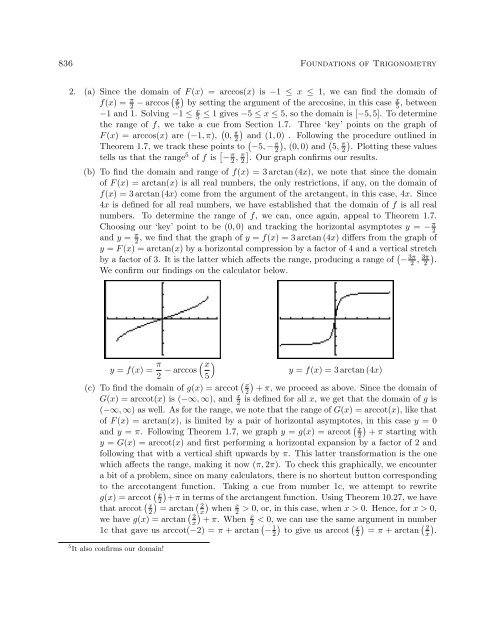Section 10.6: The Inverse Trigonometric Functions - Ostts.org
Section 10.6: The Inverse Trigonometric Functions - Ostts.org
Section 10.6: The Inverse Trigonometric Functions - Ostts.org
You also want an ePaper? Increase the reach of your titles
YUMPU automatically turns print PDFs into web optimized ePapers that Google loves.
836 Foundations of Trigonometry2. (a) Since the domain of F (x) = arccos(x) is −1 ≤ x ≤ 1, we can find the domain off(x) = π 2 − arccos ( )x5 by setting the argument of the arccosine, in this casex5 , between−1 and 1. Solving −1 ≤ x 5≤ 1 gives −5 ≤ x ≤ 5, so the domain is [−5, 5]. To determinethe range of f, we take a cue from <strong>Section</strong> 1.7. Three ‘key’ points on the graph ofF (x) = arccos(x) are (−1, π), ( 0, π )2 and (1, 0) . Following the procedure outlined in<strong>The</strong>orem 1.7, we track these points to ( −5, − π ) ( )2 , (0, 0) and 5,π2 . Plotting these valuestells us that the range 5 of f is [ − π 2 , π ]2 . Our graph confirms our results.(b) To find the domain and range of f(x) = 3 arctan (4x), we note that since the domainof F (x) = arctan(x) is all real numbers, the only restrictions, if any, on the domain off(x) = 3 arctan (4x) come from the argument of the arctangent, in this case, 4x. Since4x is defined for all real numbers, we have established that the domain of f is all realnumbers. To determine the range of f, we can, once again, appeal to <strong>The</strong>orem 1.7.Choosing our ‘key’ point to be (0, 0) and tracking the horizontal asymptotes y = − π 2and y = π 2, we find that the graph of y = f(x) = 3 arctan (4x) differs from the graph ofy = F (x) = arctan(x) by a horizontal compression by a factor of 4 and a vertical stretchby a factor of 3. It is the latter which affects the range, producing a range of ( − 3π 2 , 3π )2 .We confirm our findings on the calculator below.y = f(x) = π 2 − arccos ( x5)y = f(x) = 3 arctan (4x)(c) To find the domain of g(x) = arccot ( )x2 + π, we proceed as above. Since the domain ofG(x) = arccot(x) is (−∞, ∞), and x 2is defined for all x, we get that the domain of g is(−∞, ∞) as well. As for the range, we note that the range of G(x) = arccot(x), like thatof F (x) = arctan(x), is limited by a pair of horizontal asymptotes, in this case y = 0and y = π. Following <strong>The</strong>orem 1.7, we graph y = g(x) = arccot ( )x2 + π starting withy = G(x) = arccot(x) and first performing a horizontal expansion by a factor of 2 andfollowing that with a vertical shift upwards by π. This latter transformation is the onewhich affects the range, making it now (π, 2π). To check this graphically, we encountera bit of a problem, since on many calculators, there is no shortcut button correspondingto the arccotangent function. Taking a cue from number 1c, we attempt to rewriteg(x) = arccot ( )x2 +π in terms of the arctangent function. Using <strong>The</strong>orem 10.27, we havethat arccot ( ) (x2 = arctan 2)x whenx2> 0, or, in this case, when x > 0. Hence, for x > 0,we have g(x) = arctan ( )2x + π. Whenx2< 0, we can use the same argument in number1c that gave us arccot(−2) = π + arctan ( − 1 (2)to give us arccotx) (2 = π + arctan 2x).5 It also confirms our domain!


